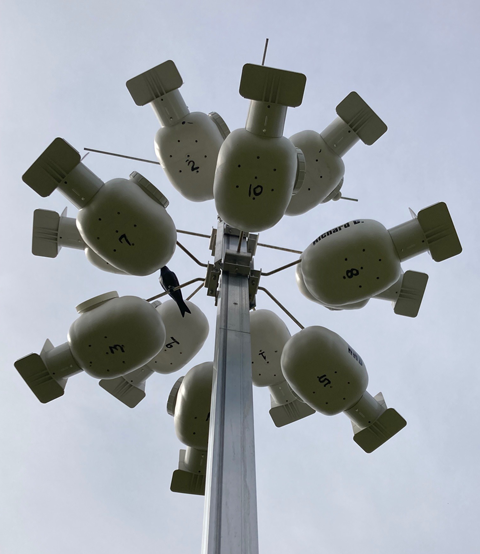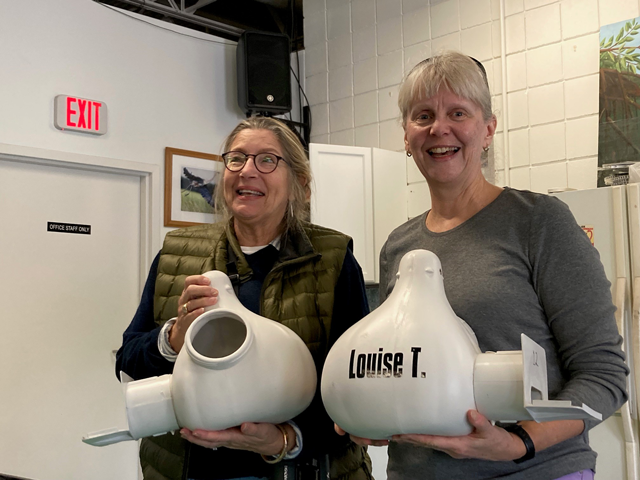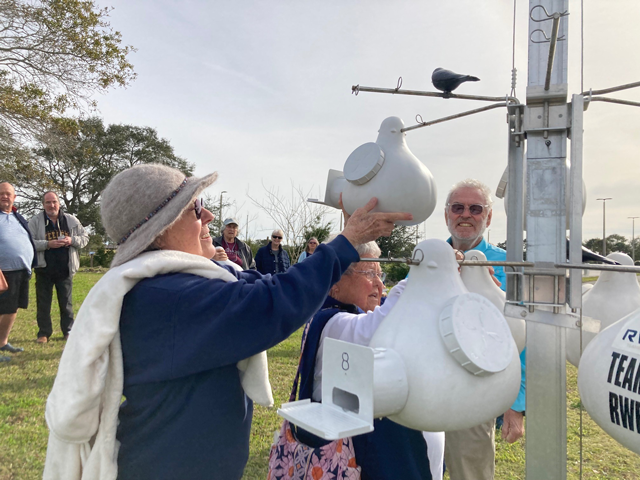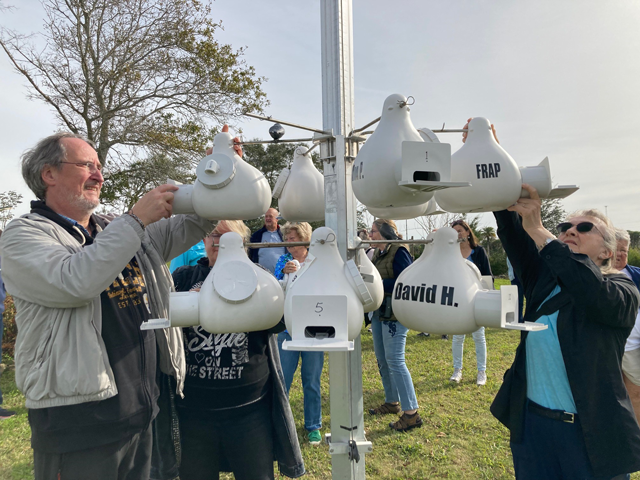By Lisa D. Mickey
The gourds are up! And now, the Southeast Volusia Audubon Society (SEVAS) chapter is ready for the purple martins to move in.
As part of its Purple Martin Project, SEVAS held the third annual “Gourd Raising” ceremony adjacent to the bird garden on Marine Discovery Center’s campus. Plastic gourd-shaped containers are used as nesting sites for the migratory purple martin – the largest swallow in North America.
The gourds are raised into position on a metal nesting tree with extending branches onto which the gourds are connected. The gourds provide potential nests for the purple martins when they arrive in Central Florida from South America. Purple martins have already arrived south of here in Brevard County.

“We had three couples of these birds laying eggs in 2023, and I think we’ll be at full house this year,” said Richard Fasse, who serves as the “purple martin landlord” for SEVAS. “We’re hoping to get nine or ten gourds filled with babies.”
Kim Ramos, who helps volunteer with the “Project NestWatch” program at the SEVAS nesting site at MDC, remembers the excitement the birds created last season when they first arrived — but it took time.
The Audubon chapter installed the gourd nests in January 2022, but no birds visited the site that year. The gourds were raised again in 2023, but there was no interest in the site by purple martins until the end of last March.
“We saw the first purple martin on top of a light pole out in the parking lot last year,” said Ramos. “Many of our volunteers had never seen these birds before, so it was really exciting when they began showing up. That excitement continued when we had eggs and chicks in the gourds.”
Six adults stayed at the gourds all nesting season from March through May. Four birds fledged in late May/early June (after they acquired their adult feathers to fly) and left the site. By June, around 14 birds began gathering together at the MDC colony site from other area nests until they were all ready to migrate south for the season.
SEVAS members and volunteers took down the gourds last July, cleaned them out and stored them until the 2024 nesting season. Prior to rehanging the gourds on the nesting tree outdoors on Jan. 3, 2024, SEVAS members and volunteers added cedar shavings and pine needles to each unit.
The gourds were then transported to the nesting tree, where they were attached with great hope and fanfare by SEVAS members. Some of the gourds are even sponsored by individuals in honor or memory of others.
“The birds like to return to a nesting site and since they only used three gourds last year, we wanted to hang out more gourds so more birds would see it as space for them,” said Ramos.
“A few ‘scouts’ will fly in and check out the area,” added Ramos. “When we see them begin placing oak leaves inside the gourds for their nests, that’s when we’ll know they are serious about nesting here. We want them to take ownership of this colony.”
If the colony is successful this year and continues to expand, Fasse said SEVAS may try to write a grant to secure another metal nesting tree for additional gourds at the MDC site. Each tree holds 12 gourds. The current nesting tree cost $13,000 and was funded by Audubon and Florida Power & Light.
Project NestWatch is a citizen-science program designed for active colony management through the Purple Martin Conservation Association. Volunteer observers are trained to monitor the nests through the egg-laying phase for egg counts, as well as to monitor the nests for predation and even nest invasions of mites. If the insects are detected on chicks in the nest, volunteers are trained to safely transfer hatchlings into a holding area while new nesting material is installed in the gourds.
Once the maturing chicks are ready to fledge, observers are needed to monitor the gourd colony when the young birds begin moving out of their nests and testing their wings to fly — sometimes prematurely. Volunteer observers can help the birds return to their nests if they fall from the gourds.
“If you look around at this site, there is plenty of habitat for food here,” said Ramos. “These birds eat insects and they catch them on the wing, so being located here on a mangrove swamp is a great place for them to nest.”
And hopefully for 2024, the MDC location will also be a perfect place for a colony of purple martins to thrive.
Click here to learn more about the Purple Martin Project or become a volunteer observer.






Follow Us!